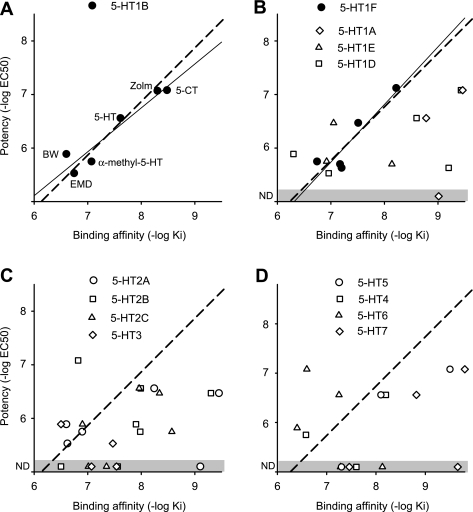Fig. 4.
Potency of 5-HT receptor agonists at inhibiting the LPR is only related to binding to 5-HT1B and 5-HT1F receptors. A: 5-HT1B receptor agonist potency (pEC50 = −log EC50) for inhibiting the LPR plotted against the agonist binding affinity to that receptor (pKi). Each agonist is indicated next to its data point: BW, BW723C86; Zolm, zolmitriptan; EMD, EMD386088. Thin line indicates significant linear correlation between potency and affinity (r = 0.96, P < 0.05, n = 6). Dashed line represents the best fit line with unit slope (potency = binding affinity + C, where C ≈ −1). B–D: similar potency-affinity scatter plots for the remaining 5-HT receptors. Thin line indicates significant linear correlation between agonist potency and affinity for 5-HT1F receptors (solid circles; r = 0.91, P < 0.05, n = 5). Dashed lines represent the unit slope line. Other receptors had no significant correlation between potency and affinity (open symbols; P > 0.05). ND and shaded zone indicate no detected effect of agonist on the LPR. Agonists used and affinities are listed in Table 1, with agonists assumed to act at a receptor only if Ki < 400 nM. Potencies are from Table 2. Potencies for 5-HT and zolmitriptan action in the presence of 5-HT1B antagonists were used (plotted) for comparison to 5-HT1D, 5-HT1E, and 5-HT1F receptor binding affinity, because these antagonists removed confounding effects of 5-HT1B receptors. Table 3 also summarizes agonists/antagonists used for each receptor.

